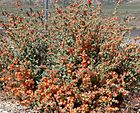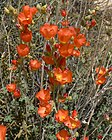Note: This is a project under development. The articles on this wiki are just being initiated and broadly incomplete. You can Help creating new pages.
Difference between revisions of "Sphaeralcea incana - Gray globemallow"
(Prabhakar moved page Gray globemallow (Sphaeralcea incana) to GSphaeralcea incana - Gray globemallow) |
|||
| (7 intermediate revisions by 2 users not shown) | |||
| Line 1: | Line 1: | ||
| − | + | '''Gray globemallow''' with the common names Sphaeralcea incana and soft globemallow. It is a desert plant in the mallow family Malvaceae. | |
| + | ==Uses== | ||
| + | {{Uses|Urinary tract}}, {{Uses|Upper intestinal tract}}, {{Uses|Cough}}, {{Uses|Common colds}}, {{Uses|Flu}}, {{Uses|Wounds}}, {{Uses|Pimples}}, {{Uses|Diarrhea}}, {{Uses|Sore throats}}<ref name="Uses"/> | ||
| + | |||
| + | ==Parts Used== | ||
| + | {{Parts Used|Dried folaige}}, {{Parts Used|Whole herb}}. | ||
| + | |||
| + | ==Chemical Composition== | ||
| + | Contains volatile oils, flavonoids, apigenin, luteolin, quercetin, kaempferol, tiliroside, triterpene glycosides including euscapic acid and tormentic acid, phenolic acids, and 3%–21% tannins. | ||
| + | |||
| + | ==Common names== | ||
| + | {{Common names|kn=|ml=|sa=|ta=|te=|hi=|en=Gray globemallow}} | ||
| + | |||
| + | ==Properties== | ||
| + | Reference: Dravya - Substance, Rasa - Taste, Guna - Qualities, Veerya - Potency, Vipaka - Post-digesion effect, Karma - Pharmacological activity, Prabhava - Therepeutics. | ||
| + | ===Dravya=== | ||
| + | |||
| + | ===Rasa=== | ||
| + | |||
| + | ===Guna=== | ||
| + | |||
| + | ===Veerya=== | ||
| + | |||
| + | ===Vipaka=== | ||
| + | |||
| + | ===Karma=== | ||
| + | |||
| + | ===Prabhava=== | ||
| + | |||
| + | ==Habit== | ||
| + | {{Habit|sub shrub}} | ||
| + | |||
| + | ==Identification== | ||
| + | ===Leaf=== | ||
| + | {{Leaf|Simple||Gooseberry-leaf globemallow leaves are circular in outline and deeply parted into 3-5 thin lobes which are again deeply cleft}}<ref name="Leaf"/> | ||
| + | |||
| + | ===Flower=== | ||
| + | {{Flower|Unisexual|1 inch long|coral to orange|5|The bell-shaped calyx is fairly densely covers with star-shaped hairs}} | ||
| + | |||
| + | ===Fruit=== | ||
| + | {{Fruit|Schizocarp|1-2 inch||With hooked hairs|many}} | ||
| + | |||
| + | ===Other features=== | ||
| + | |||
| + | ==List of Ayurvedic medicine in which the herb is used== | ||
| + | |||
| + | ==Where to get the saplings== | ||
| + | ==Mode of Propagation== | ||
| + | {{Propagation|Seeds}}, {{Propagation|Cuttings}}. | ||
| + | |||
| + | ==How to plant/cultivate== | ||
| + | Sphaeralcea species from western N. America are generally species of warm<ref name="How to plant/cultivate"/> | ||
| + | |||
| + | ==Commonly seen growing in areas== | ||
| + | {{Commonly seen|Tall grasslands}}, {{Commonly seen|Meadows}}, {{Commonly seen|Borders of forests and fields}}. | ||
| + | |||
| + | ==Photo Gallery== | ||
| + | <gallery class="left" caption="" widths="140px" heights="140px"> | ||
| + | File:Sphaeralcea ambigua 1.jpg | ||
| + | File:Sphaeralcea ambigua 4.jpg | ||
| + | File:Sphaeralcea ambigua 5.jpg | ||
| + | File:Sphaeralcea ambigua 10.jpg | ||
| + | File:Sphaeralcea ambigua 11.jpg | ||
| + | File:Sphaeralcea ambigua 12.jpg | ||
| + | File:Sphaeralcea ambigua 13.jpg | ||
| + | </gallery> | ||
| + | |||
| + | ==References== | ||
| + | <references> | ||
| + | <ref name="Leaf">[https://extension.usu.edu/rangeplants/forbsherbaceous/gooseberryleaf-globemallow Plant description]</ref> | ||
| + | <ref name="How to plant/cultivate">[http://temperate.theferns.info/plant/Sphaeralcea+incana Cultivation details]</ref> | ||
| + | <ref name="Uses">Karnataka Aushadhiya Sasyagalu By Dr.Maagadi R Gurudeva, Page no:299</ref> | ||
| + | </references> | ||
| + | |||
| + | ==External Links== | ||
| + | * [http://www.suncrestnurseries.com/pfts_show.php?id=sphai GSphaeralcea incana on sunsect nursuriea inc] | ||
| + | * [https://www.wildflower.org/plants/result.php?id_plant=spin2 GSphaeralcea incana on plant database] | ||
| + | * [https://www.quackingrassnursery.com/plant/Sphaeralcea-incana Gray globemallow quick in grass nurasry] | ||
| + | |||
| + | [[Category:Herbs]] | ||
| + | [[Category:Asteraceae]] | ||
Latest revision as of 16:55, 12 August 2020
Gray globemallow with the common names Sphaeralcea incana and soft globemallow. It is a desert plant in the mallow family Malvaceae.
Contents
- 1 Uses
- 2 Parts Used
- 3 Chemical Composition
- 4 Common names
- 5 Properties
- 6 Habit
- 7 Identification
- 8 List of Ayurvedic medicine in which the herb is used
- 9 Where to get the saplings
- 10 Mode of Propagation
- 11 How to plant/cultivate
- 12 Commonly seen growing in areas
- 13 Photo Gallery
- 14 References
- 15 External Links
Uses
Urinary tract, Upper intestinal tract, Cough, Common colds, Flu, Wounds, Pimples, Diarrhea, Sore throats[1]
Parts Used
Chemical Composition
Contains volatile oils, flavonoids, apigenin, luteolin, quercetin, kaempferol, tiliroside, triterpene glycosides including euscapic acid and tormentic acid, phenolic acids, and 3%–21% tannins.
Common names
| Language | Common name |
|---|---|
| Kannada | |
| Hindi | |
| Malayalam | |
| Tamil | |
| Telugu | |
| Marathi | NA |
| Gujarathi | NA |
| Punjabi | NA |
| Kashmiri | NA |
| Sanskrit | |
| English | Gray globemallow |
Properties
Reference: Dravya - Substance, Rasa - Taste, Guna - Qualities, Veerya - Potency, Vipaka - Post-digesion effect, Karma - Pharmacological activity, Prabhava - Therepeutics.
Dravya
Rasa
Guna
Veerya
Vipaka
Karma
Prabhava
Habit
Identification
Leaf
| Kind | Shape | Feature |
|---|---|---|
| Simple | Gooseberry-leaf globemallow leaves are circular in outline and deeply parted into 3-5 thin lobes which are again deeply cleft |
Flower
| Type | Size | Color and composition | Stamen | More information |
|---|---|---|---|---|
| Unisexual | 1 inch long | coral to orange | 5 | The bell-shaped calyx is fairly densely covers with star-shaped hairs |
Fruit
| Type | Size | Mass | Appearance | Seeds | More information |
|---|---|---|---|---|---|
| Schizocarp | 1-2 inch | With hooked hairs | many | {{{6}}} |
Other features
List of Ayurvedic medicine in which the herb is used
Where to get the saplings
Mode of Propagation
How to plant/cultivate
Sphaeralcea species from western N. America are generally species of warm[3]
Commonly seen growing in areas
Tall grasslands, Meadows, Borders of forests and fields.
Photo Gallery
References
- ↑ Karnataka Aushadhiya Sasyagalu By Dr.Maagadi R Gurudeva, Page no:299
- ↑ Plant description
- ↑ Cultivation details
External Links
- Ayurvedic Herbs known to be helpful to treat Urinary tract
- Ayurvedic Herbs known to be helpful to treat Upper intestinal tract
- Ayurvedic Herbs known to be helpful to treat Cough
- Ayurvedic Herbs known to be helpful to treat Common colds
- Ayurvedic Herbs known to be helpful to treat Flu
- Ayurvedic Herbs known to be helpful to treat Wounds
- Ayurvedic Herbs known to be helpful to treat Pimples
- Ayurvedic Herbs known to be helpful to treat Diarrhea
- Ayurvedic Herbs known to be helpful to treat Sore throats
- Herbs with Dried folaige used in medicine
- Herbs with Whole herb used in medicine
- Herbs with common name in English
- Habit - sub shrub
- Index of Plants which can be propagated by Seeds
- Index of Plants which can be propagated by Cuttings
- Herbs that are commonly seen in the region of Tall grasslands
- Herbs that are commonly seen in the region of Meadows
- Herbs that are commonly seen in the region of Borders of forests and fields
- Herbs
- Asteraceae






